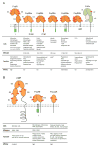Prospects for engineering HIV-specific antibodies for enhanced effector function and half-life
- PMID: 25700208
- PMCID: PMC4419828
- DOI: 10.1097/COH.0000000000000149
Prospects for engineering HIV-specific antibodies for enhanced effector function and half-life
Abstract
Purpose of review: A wealth of recent animal model data suggests that as exciting possibilities for the use of antibodies in passive immunotherapy strategies continue to develop, it will be important to broadly consider how antibodies achieve anti-HIV-1 effect in vivo.
Recent findings: Beyond neutralization breadth and potency, substantial evidence from natural infection, vaccination, and studies in animal models points to a critical role for antibody Fc receptor (FcR) engagement in reducing risk of infection, decreasing postinfection viremia, and delaying viral rebound. Supporting these findings in the setting of HIV, the clinical maturation of recombinant antibody therapeutics has reinforced the importance of Fc-driven activity in vivo across many disease settings, as well as opportunely resulted in the development and exploration of a number of engineered Fc sequence and glycosylation variants that possess differential binding to FcRs. Exploiting these variants as tools, the individual and concerted effects of antibody effector functions such as antibody-dependent cellular cytotoxicity, antibody-dependent cell-mediated virus inhibition, phagocytosis, complement-dependent cytotoxicity, antibody half-life, and compartmentalization are now being explored. As exciting molecular therapies are advanced, these studies promise to provide insight into optimal in-vivo antibody activity profiles.
Summary: Careful consideration of recent progress in understanding protective antibody activities in vivo can point toward how tailoring antibody activity via Fc domain modification may enable optimization of HIV prevention and eradication strategies.
Conflict of interest statement
A.W.B. is cofounder and CEO of Zepteon, Inc., and coinventor of patents pending (WO2013013193 and US 20130084648 A1). M.E.A. receives a book royalty from Elsevier.
Figures


References
-
- DiLillo DJ, Tan GS, Palese P, Ravetch JV. Broadly neutralizing hemagglutinin stalk-specific antibodies require FcgammaR interactions for protection against influenza virus in vivo. Nat Med. 2014;20:143–151. This article demonstrates that neutralization activity is insufficient and FcRs are required to fully account for the protection afforded from influenza infection by the stem-specific antibodies that have raised hopes for a universal flu vaccine. - PMC - PubMed
-
- Bournazos S, Chow SK, Abboud N, et al. Human IgG Fc domain engineering enhances antitoxin neutralizing antibody activity. J Clin Invest. 2014;124:725–729. This work finds that altering the Fc domain of an antibody specific to a secreted anthrax toxin has a dramatic impact on protection from intoxication. A variant with enhanced binding to activating FcR permits survival of approximately 75% of mice, whereas only approximately 10% of mice survive when treated with native IgG1, and none survives when effector function is eliminated either via point mutation of the IgG or genetically via FcγR knockout. - PMC - PubMed
-
- Varshney AK, Wang X, Aguilar JL, et al. Isotype switching increases efficacy of antibody protection against staphylococcal enterotoxin B-induced lethal shock and Staphylococcus aureus sepsis in mice. MBio. 2014;5:e01007–01014. This work further generalizes the result observed above by demonstrating that isotypic variation impacts protection against staphylococcal enterotoxin B. - PMC - PubMed
-
- Furness AJ, Vargas FA, Peggs KS, Quezada SA. Impact of tumour micro-environment and Fc receptors on the activity of immunomodulatory antibodies. Trends Immunol. 2014;35:290–298. This review summarizes recent articles that call into question the presumed mechanism of immunomodulatory antibodies as receptor agonists/antagonists and suggests that effector functions such as ADCC are involved. - PubMed
-
- Ratner M. Genentech’s glyco-engineered antibody to succeed Rituxan. Nat Biotechnol. 2014;32:6–7. - PubMed
Publication types
MeSH terms
Substances
Grants and funding
LinkOut - more resources
Full Text Sources
Medical
Research Materials

